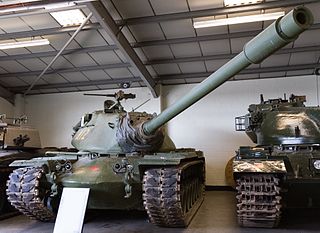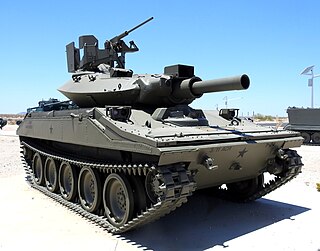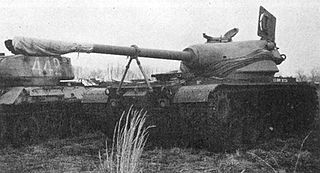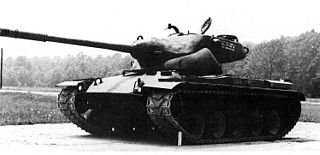 W
WThis article deals with the history and development of American tanks from the end of World War II, and during the Cold War.
 W
WThe M24 Chaffee is an American light tank used during the later part of World War II; it was also used in post–World War II conflicts including the Korean War, and by the French in the War in Algeria and the First Indochina War. In British service it was given the service name Chaffee after the United States Army General Adna R. Chaffee Jr., who helped develop the use of tanks in the United States armed forces. M24s were mostly removed from U.S. and NATO armies by the 1960s, but remained in service with some Third World countries.
 W
WThe Chrysler TV-8 was a tank design project by Chrysler in the 1950s. The tank was intended to be a medium tank capable of land and amphibious warfare. The design was never produced.
 W
WThe M1 Abrams is a third-generation American main battle tank designed by Chrysler Defense and named for General Creighton Abrams. Conceived for modern armored ground warfare and now one of the heaviest tanks in service at nearly 68 short tons, it introduced several innovative features, including a multifuel turbine engine, sophisticated Chobham composite armor, a computer fire control system, separate ammunition storage in a blow-out compartment, and NBC protection for crew safety. Initial models of the M1 were armed with a licensed-produced 105 mm Royal Ordnance L7 gun, while later variants feature a licensed Rheinmetall 120 mm L/44.
 W
WThe United Defense M8 Armored Gun System was an American light tank that was intended to replace the M551A1 Sheridan in the 82nd Airborne Division, as well as being expected to replace TOW-equipped Humvees in the 2nd Armored Cavalry Regiment. The M8 project was eventually canceled in 1997. Its role in the 2nd ACR was eventually taken by the M1128 Mobile Gun System, but a modernized version of the vehicle is in trials with the US Army once more.
 W
WThe M41 Walker Bulldog, officially 76-mm Gun Tank, M41, was an American light tank developed for armed reconnaissance purposes. It was produced by Cadillac between 1951 and 1954 and marketed successfully to the United States Army as a replacement for its aging fleet of World War II vintage M24 Chaffee tanks. Although engineered as a reconnaissance vehicle, the M41's weight and armament also made it effective in the close infantry support role and for rapid airborne deployments. Upon entering US service, all M41s received the designation Little Bulldog and subsequently, Walker Bulldog after the late General Walton Walker, who was killed in a Jeep accident in 1950. The M41 was the first postwar American light tank to see worldwide service, and was exported in considerable numbers by the United States, particularly to Asia.
 W
WThe M41 Walker Bulldog, officially 76-mm Gun Tank, M41, was an American light tank developed for armed reconnaissance purposes. It was produced by Cadillac between 1951 and 1954 and marketed successfully to the United States Army as a replacement for its aging fleet of World War II vintage M24 Chaffee tanks. Although engineered as a reconnaissance vehicle, the M41's weight and armament also made it effective in the close infantry support role and for rapid airborne deployments. Upon entering US service, all M41s received the designation Little Bulldog and subsequently, Walker Bulldog after the late General Walton Walker, who was killed in a Jeep accident in 1950. The M41 was the first postwar American light tank to see worldwide service, and was exported in considerable numbers by the United States, particularly to Asia.
 W
WThe M41 Walker Bulldog, officially 76-mm Gun Tank, M41, was an American light tank developed for armed reconnaissance purposes. It was produced by Cadillac between 1951 and 1954 and marketed successfully to the United States Army as a replacement for its aging fleet of World War II vintage M24 Chaffee tanks. Although engineered as a reconnaissance vehicle, the M41's weight and armament also made it effective in the close infantry support role and for rapid airborne deployments. Upon entering US service, all M41s received the designation Little Bulldog and subsequently, Walker Bulldog after the late General Walton Walker, who was killed in a Jeep accident in 1950. The M41 was the first postwar American light tank to see worldwide service, and was exported in considerable numbers by the United States, particularly to Asia.
 W
WThe M46 Patton was an American medium tank designed to replace the M26 Pershing and M4 Sherman. It was one of the U.S Army's principal medium tanks of the early Cold War, with models in service from 1949 until the mid-1950s. It was not widely used by U.S. Cold War allies, being exported only to Belgium, and only in small numbers to train crews on the upcoming M47 Patton.
 W
WThe M47 Patton was an American main battle tank, a development of the M46 Patton mounting an updated turret, and was in turn further developed as the M48 Patton. It was the second American tank to be named after General George S. Patton, commander of the U.S. Third Army during World War II and one of the earliest American advocates of tanks in battle.
 W
WThe M48 Patton is an American first generation main battle tank (MBT) introduced in February 1952, being designated as the 90mm Gun Tank: M48. It was designed as a replacement for the M26 Pershing, M4 Sherman variants and M46 Pattons used in the Korean War, and as the successor to the M47 Patton. Nearly 12,000 M48s were built, mainly by Chrysler and American Locomotive Company, from 1952 to 1961. The M48 underwent many design modifications and improvements during its production life. This led to a wide variety of suspension systems, cupola styles, power packs, fenders and other details among individual tanks.
 W
WThe M60 is an American second generation main battle tank (MBT). It was officially standardized as the Tank, Combat, Full Tracked: 105-mm Gun, M60 in March 1959. Although developed from the M48 Patton, the M60 tank series was never officially christened a "Patton" tank. It has been sometimes informally grouped as a member of the Patton tank family. The design similarities are evident comparing the original version of the M60 and the M48A2. The US Army considered it a "product-improved descendant" of the Patton tank's design. The United States fully committed to the MBT doctrine in 1963 when the Marine Corps retired the last (M103) heavy tank battalion. The M60 tank series became America's primary main battle tank during the Cold War. Over 15,000 M60s were built by Chrysler. Hull production ended in 1983, but 5,400 older models were converted to the M60A3 variant ending in 1990.
 W
WThe M60 is an American second generation main battle tank (MBT). It was officially standardized as the Tank, Combat, Full Tracked: 105-mm Gun, M60 in March 1959. Although developed from the M48 Patton, the M60 tank series was never officially christened a "Patton" tank. It has been sometimes informally grouped as a member of the Patton tank family. The design similarities are evident comparing the original version of the M60 and the M48A2. The US Army considered it a "product-improved descendant" of the Patton tank's design. The United States fully committed to the MBT doctrine in 1963 when the Marine Corps retired the last (M103) heavy tank battalion. The M60 tank series became America's primary main battle tank during the Cold War. Over 15,000 M60s were built by Chrysler. Hull production ended in 1983, but 5,400 older models were converted to the M60A3 variant ending in 1990.
 W
WThe M60 is an American second generation main battle tank (MBT). It was officially standardized as the Tank, Combat, Full Tracked: 105-mm Gun, M60 in March 1959. Although developed from the M48 Patton, the M60 tank series was never officially christened a "Patton" tank. It has been sometimes informally grouped as a member of the Patton tank family. The design similarities are evident comparing the original version of the M60 and the M48A2. The US Army considered it a "product-improved descendant" of the Patton tank's design. The United States fully committed to the MBT doctrine in 1963 when the Marine Corps retired the last (M103) heavy tank battalion. The M60 tank series became America's primary main battle tank during the Cold War. Over 15,000 M60s were built by Chrysler. Hull production ended in 1983, but 5,400 older models were converted to the M60A3 variant ending in 1990.
 W
WThe M60 is an American second generation main battle tank (MBT). It was officially standardized as the Tank, Combat, Full Tracked: 105-mm Gun, M60 in March 1959. Although developed from the M48 Patton, the M60 tank series was never officially christened a "Patton" tank. It has been sometimes informally grouped as a member of the Patton tank family. The design similarities are evident comparing the original version of the M60 and the M48A2. The US Army considered it a "product-improved descendant" of the Patton tank's design. The United States fully committed to the MBT doctrine in 1963 when the Marine Corps retired the last (M103) heavy tank battalion. The M60 tank series became America's primary main battle tank during the Cold War. Over 15,000 M60s were built by Chrysler. Hull production ended in 1983, but 5,400 older models were converted to the M60A3 variant ending in 1990.
 W
WThe Flame Thrower Tank M67 is an American medium flame tank that was briefly used by the U.S. Army, and later by the U.S. Marine Corps during the Vietnam War. It was the last flamethrower tank used in American military service.
 W
WThe M103 Heavy Tank was a heavy tank that served in the United States Army and the United States Marine Corps during the Cold War. Introduced in 1957, it served through 1974, by which time evolution of the concept of a main battle tank had rendered heavy tanks obsolete.
 W
WThe M551 "Sheridan" AR/AAV was a light tank developed by the United States and named after General Philip Sheridan, of American Civil War fame. It was designed to be landed by parachute and to swim across rivers. It was armed with the technically advanced but troublesome M81/M81 Modified/M81E1 152mm gun/launcher, which fired both conventional ammunition and the MGM-51 Shillelagh guided anti-tank missile.
 W
WThe MBT-70 was an American–West German joint project to develop a new main battle tank during the 1960s.
 W
WThe M26 Pershing was a heavy tank/medium tank of the United States Army. The tank was named after General of the Armies John J. Pershing, who led the American Expeditionary Force in Europe in World War I. It was used in the last months of World War II during the Invasion of Germany and extensively during the Korean War.
 W
WThe Stingray, sometimes known as the Commando Stingray, is a light tank produced by Textron Marine & Land Systems division. It was specifically designed to use as many existing components of other American armored fighting vehicles as possible to keep costs down. The Stingray was a private venture project aimed at foreign countries. As of 2020, Textron has kept the Stingray name registered.
 W
WThe T54 was a series of prototype American tanks of the 1950s with three different turrets, all armed with a 105 mm gun, mounted on the M48 Patton chassis. The T54 had a conventional turret with an autoloader with 3 shells, the T54E1 had an oscillating design with an autoloader, and the T54E2 had a conventional turret with a human loader. The turret on T54E1 was similar to that of the T69 in its oscillating design and in that it held a crew of three and a nine-round drum autoloader under the gun. The T54E1 was abandoned in 1956 and in 1957 the entire project was cancelled in favor of the T95 Medium Tank.
 W
WThe T69 was a prototype American medium tank with an oscillating turret mounting a 90mm cannon with an eight-round drum autoloader. It held a crew of three. Developed on the basis of the T42 experimental medium tank in mid-50s, the vehicle never entered mass production.
 W
WT92 Light Tank, or 76-mm Gun Tank, T92, was an American light tank developed in the 1950s by Aircraft Armaments. At 18.5 tonnes, 5m length, it was designed as an airborne/airdropped replacement for the 5.1 tonnes heavier M41 Walker Bulldog. The T92 was never accepted into service.
 W
WThe T95 was an American prototype medium tank developed from 1955 to 1959. These tanks used many advanced or unusual features, such as siliceous-cored armor, a new transmission, and the OPTAR fire-control system. The OPTAR incorporated an electro-optical rangefinder and was mounted on the right side of the turret, and was used in conjunction with the APFSDS-firing 90 mm T208 smoothbore gun, which had a rigid mount without a recoil system. In addition, although the tanks were designed with a torsion beam suspension, a hydropneumatic suspension was fitted, and one of the tanks was fitted with a Solar Saturn gas turbine for demonstration purposes.
 W
WThe M41 Walker Bulldog, officially 76-mm Gun Tank, M41, was an American light tank developed for armed reconnaissance purposes. It was produced by Cadillac between 1951 and 1954 and marketed successfully to the United States Army as a replacement for its aging fleet of World War II vintage M24 Chaffee tanks. Although engineered as a reconnaissance vehicle, the M41's weight and armament also made it effective in the close infantry support role and for rapid airborne deployments. Upon entering US service, all M41s received the designation Little Bulldog and subsequently, Walker Bulldog after the late General Walton Walker, who was killed in a Jeep accident in 1950. The M41 was the first postwar American light tank to see worldwide service, and was exported in considerable numbers by the United States, particularly to Asia.